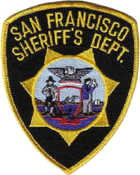San Francisco Sheriff's Department
| City and County of San Francisco Sheriff's Office | |
|---|---|
 Patch of the San Francisco Sheriff's Office | |
 Seal of the San Francisco Sheriff's Office | |
 Flag of the City and County of San Francisco | |
| Common name | San Francisco Sheriff's Office |
| Abbreviation | SFSO |
| Agency overview | |
| Formed | 1850 |
| Employees | 950 |
| Jurisdictional structure | |
| Operations jurisdiction | San Francisco, California, United States |
 | |
| Jurisdiction of San Francisco Sheriff's Department | |
| Legal jurisdiction | As per operations jurisdiction |
| Operational structure | |
| Deputies | 850 |
| Civilian employees | 100 |
| Sheriff responsible | |
| Facilities | |
| Jails | 8 |
| Website | |
| http://www.sfsheriff.com/ | |
The San Francisco Sheriff's Office (SFSO), officially the City and County of San Francisco Sheriff's Office, is the sheriff's office for the City and County of San Francisco. The department has 850 deputized personnel, and support staff.
The primary function of the SFSO is to operate the system of county jails where there is an average population of 2,200 inmates, and a number of individuals on supervised release programs.
The SFSO also provides security and law enforcement in the following locations in San Francisco:
- the civil and criminal courts
- City Hall
- the Emergency Communications & Dispatch center
- San Francisco General Hospital, Laguna Honda Hospital, and several public health clinics
The current sheriff is Paul Miyamoto, the first Asian-American sheriff in California.[1]
The SFSO is a separate organization from the San Francisco Police Department. However, SFSO deputies and SFPD officers have all attended a POST-mandated police academy, and are duly sworn California peace officers.
Divisions[]
The department has four divisions:
Administration and Programs Division: Performs functions related to personnel, training, backgrounds, in-jail programs, charter school, community programs and Prisoner Legal Services.
Custody Division: Performs custody operations, hospital ward security, classification and I.D. processing.
Field Support and Services Division: Performs civil processes, court security, central warrants, institutional patrol, investigations unit, building security, transportation, K-9, and emergency response and special events.
Management Division: Performs functions related to the overall management of the department to include fiscal operations, information technology services, facilities maintenance, and peer support.
Rank structure[]
| Title | Insignia |
|---|---|
| Sheriff | |
| Undersheriff | |
| Assistant Sheriff | |
| Chief Deputy | |
| Captain | |
| Lieutenant | |
| Sergeant | |
| Deputy |
County Jails[]


San Francisco County operates eight jails, with approximately 55,000 people booked annually. Two of these jails are located in the Hall of Justice on Bryant Street. One of the jails is located in ward 7D/7L in San Francisco General Hospital. Two jails are located at the San Bruno Complex, located ten miles south of San Francisco.
The largest San Francisco jail complex is in an unincorporated part of San Mateo County between Pacifica and San Bruno.[2] The San Bruno complex is home to County Jail 5, a modern direct-supervision facility which was opened in 2006.
The new County Jail 5 replaced the 1934 San Bruno Jail, which had been designated County Jail 3. Before its closure in 2006, the old San Bruno jail was the oldest operating county jail west of the Mississippi River. When opened in 1934, it replaced the outdated Ingleside jails, which dated from the late 1800s, and were located on the site of today's City College of San Francisco. The 1934 building was demolished in 2012. Just to the west of County Jail 5 is County Jail 6, which opened in 1989.
Prior to the new facility opening, the most modern San Francisco Jail was the one located near the Hall of Justice on Seventh Street. Opened in 1994, the complex is actually two jails. This main complex jail is a "direct supervision facility [that] has become a national model for program-oriented prisoner rehabilitation."[citation needed] The second, which acts as the main intake and release facility for the city, was praised by Pulitzer Prize-winning architecture critic Allan Temko as "a stunning victory for architectural freedom over bureaucratic stupidity." While in custody, prisoners are afforded the opportunity to attend various classes that can earn credit towards a high school diploma.[3]
Intake & Release[]
- County Jail 1 (425 7th Street, near Hall of Justice, San Francisco)
Classification[]
- County Jail 2 (425 7th Street, San Francisco)
Housing[]
- County Jail 2 (425 7th Street, San Francisco)
- County Jail 3 (Hall of Justice, 850 Bryant Street, 6th Floor, San Francisco)
- County Jail 4 (Hall of Justice, 850 Bryant Street, 7th Floor, San Francisco)
- County Jail 5 (1 Moreland Drive, San Bruno) (New state-of-the-art facility opened in 2006)
- County Jail 6 (1 Moreland Drive, San Bruno)
- County Jail 7 (Ward 7D/7L of San Francisco General Hospital)
Field Services[]

Sheriff's Patrol Division[]
The San Francisco Sheriff's Office provides patrol and law enforcement services to San Francisco General Hospital and Laguna Honda Hospital in an agreement with the Department of Public Health. In 2004 the San Francisco Sheriff's Office absorbed the personnel and police functions of the Institutional Police Department (IPD). The department fields a 60-member patrol force for the two hospitals, and several public health clinics throughout the city and county. This is a full service patrol unit that answers all calls for service within the Sheriff's Office’s jurisdiction. The Sheriff’s Office is also the primary provider of law enforcement services to the Emergency Communications Dispatch Center.
Courts Division[]
The Sheriff’s Office provides security to the criminal and civil courts in the city and county. These deputies transport defendants to court, act as bailiffs, provide building security, and respond to emergency calls from the courts.
City Hall Patrol Unit[]
Deputies in this unit provide security to San Francisco City Hall. City Hall maintains San Francisco's governing body, the Mayor's office , the Board of Supervisors, and the Office of the Sheriff. Deputy Sheriff's are responsible for providing law enforcement services as well overseeing the screening process of public and their property for prohibited and dangerous objects and materials prior to entering the building.
Hall of Justice Security[]
San Francisco's Hall of Justice houses many of the city and county's main offices, including the chief of police and the district attorney. In addition, the Hall of Justice is home to a district police station, the criminal courts, Central Warrants Bureau, the SFPD Inspector's Bureau, and two county jails. The deputies in this unit are responsible for the security of the building, the main public entrance, and responding to emergency calls in the building.
Transportation Unit[]
The deputies in this unit transport prisoners to and from court. They also transport prisoners between the various jails run by the department when prisoner housing is changed and they need to be transferred. This unit transfers inmates to various prisons throughout California.
Investigations Unit[]
The San Francisco Sheriff's Office has deputy sheriffs assigned to investigate violent, narcotics and property crimes at county facilities. The investigation unit provides a complete investigation on any crime committed within the county. The investigative unit also handles internal investigations of misconduct.
Warrant Service Unit[]
These deputies detect and arrest people with outstanding warrants who are wanted by the city and County of San Francisco and other jurisdictions. They work in plain clothes and drive in unmarked vehicles and work in conjunction with SFPD Fugitive Recovery Enforcement Teams, San Francisco County Probation Officers, California State Parole Agents and other Peace Officers coming into San Francisco who are outside their jurisdiction.
Central Warrants Bureau[]
In 1998, the Sheriff's Office took control of the Central Warrants Bureau (CWB) from the police department. This unit maintains all San Francisco County felony, misdemeanor, and traffic warrants. The deputies arrest suspects with outstanding warrants, write citations, and verify warrants for arresting agencies. The unit also arrests and transports from other counties those persons with outstanding San Francisco warrants.
K-9 Unit[]
The Sheriff’s Office has four canine units to perform a variety of search duties for the areas under the Sheriff's control. Currently SFSD has two narcotics detecting dogs and two explosive/bomb detecting dogs.
Civil Unit[]
The Sheriff’s Office’s Civil Unit carries out judgements of the San Francisco Civil Courts. The unit serves court orders, including restraining orders, property seizures, evictions, and civil bench warrants. The unit assists elderly, handicapped and indigent civil evictees by coordinating services with dozens of community assistance agencies throughout San Francisco. Since the program was initiated in 1980, more than 20,000 evictees and landlords have been assisted.[citation needed]
Emergency Services Unit[]
The San Francisco Sheriff's Office maintains a highly trained Emergency Services Unit (ESU). An ESU assignment is a concurrent assignment for deputy sheriffs that have qualified by passing a series of tests. (physical agility, firearms tests and an interview process) There are currently over 100 members of the ESU. The ESU performs a wide range of functions and is the San Francisco Sheriff's Office's main response unit for large special events such as protests, large city sponsored events, high-risk prisoner transport, large jail disturbances, or terrorist activity.
Special Response Team[]
The Sheriff’s Office also has a Special Response Team (SRT), who have been trained in special weapons and tactics. These deputies are selected from the ranks of the Emergency Services Unit after rigorous physical testing as well as showing a proficiency in firearms and problem solving while under stress. The SRT includes forward observers and snipers who have additional training in their specialty. This elite group trains for significant emergencies and events occurring in areas under the sheriff's control which are beyond the capacity of the Emergency Service Unit. Some of these duties include responding to active shooter situations, dealing with barricaded subjects, executing high risk warrants, completing high-risk transports and providing dignitary security.
See also[]
- List of law enforcement agencies in California
- Jails of San Francisco, California
- Sheriffs in the United States
- San Francisco Police Department
References[]
- ^ https://sanfrancisco.cbslocal.com/2020/01/07/san-francisco-to-swear-in-paul-miyamoto-as-californias-first-asian-american-sheriff/
- ^ "Archived copy" (PDF). Archived from the original (PDF) on 2007-07-05. Retrieved 2006-07-28.CS1 maint: archived copy as title (link)
- ^ "San Francisco Sheriff's Department : Jail". San Francisco Sheriff's Department. Archived from the original on March 19, 2006. Retrieved March 23, 2006.
External links[]
- Government of San Francisco
- Sheriffs' departments of California
- Law enforcement in the San Francisco Bay Area
- 1850 establishments in California
